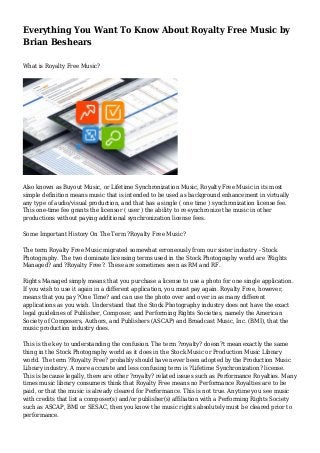
Everything You Want To Know About Royalty Free Music by Brian Beshears
- 1. Everything You Want To Know About Royalty Free Music by Brian Beshears What is Royalty Free Music? Also known as Buyout Music, or Lifetime Synchronization Music, Royalty Free Music in its most simple definition means music that is intended to be used as background enhancement in virtually any type of audio/visual production, and that has a single ( one time ) synchronization license fee. This one-time fee grants the licensor ( user ) the ability to re-synchronize the music in other productions without paying additional synchronization license fees. Some Important History On The Term ?Royalty Free Music? The term Royalty Free Music migrated somewhat erroneously from our sister industry - Stock Photography. The two dominate licensing terms used in the Stock Photography world are ?Rights Managed? and ?Royalty Free?. These are sometimes seen as RM and RF. Rights Managed simply means that you purchase a license to use a photo for one single application. If you wish to use it again in a different application, you must pay again. Royalty Free, however, means that you pay ?One Time? and can use the photo over and over in as many different applications as you wish. Understand that the Stock Photography industry does not have the exact legal guidelines of Publisher, Composer, and Performing Rights Societies, namely the American Society of Composers, Authors, and Publishers (ASCAP) and Broadcast Music, Inc. (BMI), that the music production industry does. This is the key to understanding the confusion. The term ?royalty? doesn?t mean exactly the same thing in the Stock Photography world as it does in the Stock Music or Production Music Library world. The term ?Royalty Free? probably should have never been adopted by the Production Music Library industry. A more accurate and less confusing term is ?Lifetime Synchronization? license. This is because legally, there are other ?royalty? related issues such as Performance Royalties. Many times music library consumers think that Royalty Free means no Performance Royalties are to be paid, or that the music is already cleared for Performance. This is not true. Anytime you see music with credits that list a composer(s) and/or publisher(s) affiliation with a Performing Rights Society such as ASCAP, BMI or SESAC, then you know the music rights absolutely must be cleared prior to performance.
- 2. Music Clearance, Performing Rights Societies and Cue Sheets A ?Performance? is most commonly when a copyright ( song ) is aired in a broadcast such as a Radio/TV/Cable program, radio station playlists, Satellite radio such as XM or Sirius, etc.. Another common ?Performance? is a concert hall where people are gathered to hear music. Broadcasters pay annual fees to ASCAP, BMI and SESAC to clear the performances of music on their broadcasts. For this reason, it is almost never the responsibility of an audio/video producer, or almost all Music Library users, to be responsible to pay for music clearance or a performance royalty: it is the responsibility of the broadcaster. When a producer creates a production program that is to be aired with a broadcaster, they simply just need to fill out a quick form called a Cue Sheet. Cue sheets simply contain information about the songs used in a single production so that a broadcaster may accurately report to the performing rights societies what is being used. The performing rights societies then forward the monies collected by the broadcasters to the applicable composers and publishers. Using Royalty Free Music in mass duplicated productions or ?products for sale? Many producers access Music Libraries for content that is used in productions that are to be mass duplicated. Some of these are not for sale such as Promotional DVD?s or electronically delivered intra-company sales training, etc. Other examples that are for sale include Instructional videos and even a Film/TV program sold on DVD. Most music libraries allow for a few thousand duplications of productions containing their music with no extra fee. They are all a little different, so you have to check with them. This extra fee is legally considered a ?mechanical license? but is often referred to as a mass duplication license. Fees are sometimes dependent upon how many duplications are to be manufactured. Many libraries now offer a simplified license that allows for an unlimited number of duplications to be made. This article was significantly condensed. To view the full version that goes into much more detail, please visit http://www.royaltyfreemusicrevolution.com/blog/everything-you-wanted-to-know-about-royalty-free- music-part-1/.